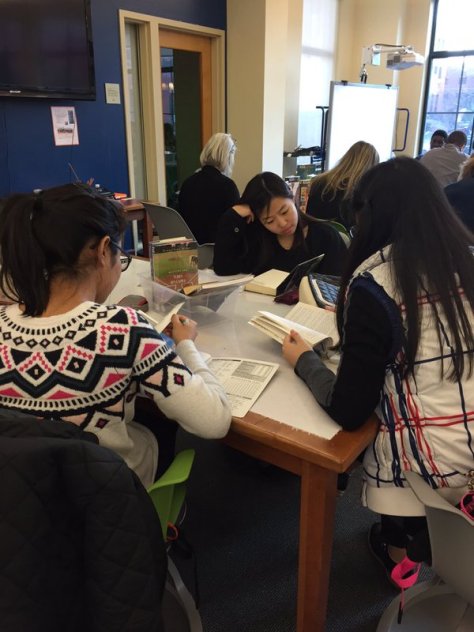
On Thursday, I took my students to our library, and our Director of Library Services, Jenn Hanson, booktalked several titles. Next, students took 30 seconds to select a book from the clear plastic bins at each table (or grabbed one of the books she booktalked). Students read the books for four minutes, then gave the books a rating (whatever rating scale they wanted to use), and put the book back. Jenn called it “book speed dating,” and I think the students really liked it. We did four rounds, and typically, students had a book in mind that they wanted to read after that.
Students checked out books and we calibrated their reading speed. I asked them to read at a comfortable pace for 10 minutes. After that we multiplied how many pages they could read in 10 minutes by 6 to get the number of pages per hour, then doubled that number for the pages that could be read in 2 hours. I want them to read 2 hours per week at a comfortable pace.
In class the next day, there were some questions about pages. What if some books had poems and you could read them faster? Yes, that happens, so you need to recalibrate for the new book when you get it.

I participated too, and I was able to find several books to put on my own reading list. I had asked students to turn to the last page of their Reader’s/Writer’s Notebooks to make a list, and every student had several titles written down.
I didn’t notice any overt resistance. Everyone, even my students who describe themselves as non-readers, found a book. In class the next day, all but one of the students remembered to bring their books (and I happened to have had a copy of his book to lend him for class).
I booktalked Sherman Alexie’s The Absolutely True Diary of a Part-Time Indian the next day (only in one class because the other doesn’t meet again until Monday, at which time I’ll share the Alexie book with that class). I told students if it sounded interesting to put it on their list, and I notice that several students wrote the title down in their notebooks.
I also asked students to find one sentence that they really liked for some reason in their independent read and copy it down in their Reader’s/Writer’s Notebook then write one or two sentences about why they liked it. We all shared our sentences. I suggested that if someone’s sentence sounded interesting, students might want to write the title of the book it came from down as well.
The independent reading is off to an encouraging start. The students all chose great books, and Jenn was wonderful at engaging the students in selecting their books.
Updated 12/5/15 to add a link to Jenn’s post about our library visit on her blog.

Please keep it up. After reading BOOK LOVE by Penny Kittle, I’ve done tons of book talks upfront at the beginning of the year, spending OODLES of time on them. Very well worth it when their list is long enough to last them to winter break. It really shows them what you believe is important. Now I throw in a couple every week, and the students are sharing, too! We keep ours all in one spot so the kids can look back at any time and students in other classes can hear the book talks, too: scholarsrm239.weebly.com/book-talks–read-alouds
Enjoy the journey and I hope they continue to read on their own because you’re giving them time IN class!
I would like to say that I think this is a brilliant way to help students choose what to read. As a student teacher, I am just now starting to think about different ways to get students interested in different genres of books, texts they wouldn’t usually read, and this would be a good, low commitment way to do so. My mentor teacher is a strong believer in student choice when it comes to reading, but there are always issues when it comes to actually choosing the books. Usually, there is about 25% of the class that chose a reading that bored them, which resulted in them ignoring their reading assignments. We can prevent some of these issues by doing this activity. Thank you for the idea!
It worked really well. We’re lucky to have Jenn at Worcester Academy.